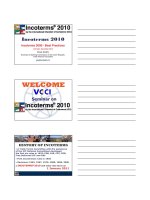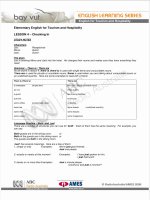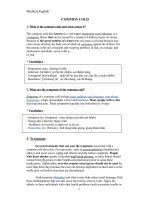ENGLISH 9
Bạn đang xem bản rút gọn của tài liệu. Xem và tải ngay bản đầy đủ của tài liệu tại đây (97.46 KB, 3 trang )
<span class='text_page_counter'>(1)</span><div class='page_container' data-page=1>
<b>UNIT 9. LESSON 2: READ</b>
<b>Period 51</b>
<b>A. OBJECTIVES : </b>
- By the end of this lesson, Ss will be able to read the text about natural disasters for specific
information and do exercises.
<b>Knowledge</b>:
+ Read a passage about natural disasters for specific information.
+ Get general background information on some common natural disasters such as earthquakes,
tidal waves, typhoon, volcanoes and tornadoes through 2 comprehension exercise: "true/ false
and" "sentence completion"
Skills: reading
<b>Attitude: teach ss the good attitude to the subject.</b>
<b>B.TEACHING AIDS:</b>
Lesson plans, Tieng Anh 9, chalk, real situations, projector, computer speaker
<b>C. METHODS:</b>
Matching, statement predictions, asking and answering
<b>D. CONTENTS . </b>
<b>I. Organization</b>
<b>Class Date of teaching Absent Ss</b>
<b>9D1</b> ……….. ……….
<b>9D2 ………</b> ………
<b>II. Warm-up (5’)</b>
<b> Matching</b>
T: Give definition of 4 natural disasters that
Ss will learn in the lesson
Work in groups and do the matching
- Ask Ss to match the names of the disasters
to its correct definition
- Give correct answers
1. e 2.d 3.b 4.a 5.c
<b>III. New lesson </b>
<b>Step 1: Pre-reading (12’)</b>
Act 1. Eliciting vocab
Listen, guess its meaning and copy down.
- Repeat chorally , individually
1. Earthquake a. mountain or hill with
openings through which ashes
and gases ejected
2. tidal wave b. violent storm especially in
east Asian seas
3. typhoon c. violent storm over small
area
4. volcano d. another word for tsunami,
waves caused by tides
5. Tornado e. sudden and violent
movements of the earth surface
a tidal wave: song than
a tornado: con loc xoay
+ Pacifc rim: Vành đai Thái Bình Dương
+ Collapse (v): sụp đổ
</div>
<span class='text_page_counter'>(2)</span><div class='page_container' data-page=2>
-Checking understanding: R.O.R
<b>Act 2. True- False Statements Predictions</b>
* Set the scene: There are 6 statements about
the information of some to natural disaster.
All of you have to read them and guess
whether they are true or false.
- Hang the poster of T/F statements on the
board.
- Get students to work in pairs to guess which
statements are true and which are false.
- Students predict whether the six statements
are true or false.
- Give feedback
<b>Step 2: While-reading (17’)</b>
<b>Act 1. Checking predictions:</b>
- Have students read the text on page 78 and
check their perfection
- Students read for the first time and check
their predictions.
Get students to correct false statements.
Answer key:
1. T 2. T 3. F 4. T 5. F 6. T
<b>Act 2. Complete the sentences</b>
- Have students work in pairs and complete
the sentences in exercise 5b on page 79.
<i>Answer keys:</i>
1. The majority of earthquakes occur around
the Pacific Rim.
2. During the earthquake in Kobe, many
people were killed when homes, office blocks
and highways collapsed.
3. A tidal wave can only occur when there is
an abrupt shift in the underwater movement
of the Earth.
4. In Australia, a tropical storm is known as a
cyclone
+ Shift (n) sự dịch chuyển, thay đổi
+ Hurricane (n) = cyclone = typhoon
+ Erupt (v): Eruption (n): Phun trào
+ Funnel (n): Cái phễu
1. Most of earthquakes in the world occur in
the Ring of Fire.
2. The earthquake in Kobe in 1995 caused
severe damage.
3. A huge tidal wave traveled from California
to Alaska and hit Anchorage in the 1960s.
4. Typhoon, hurricane and tropical storm are
different words for the same natural disasters.
5. The eruption of Mount Pinatubo is the
world’s largest ever volcano eruption
6. A Tornado looks like a funnel
<b>2.Reading </b>
1. T
2. T
3. F A huge tidal wave traveled from
Alaska to California
4. T
5. F The eruption of Mount Pinatubo is the
world’s largest volcanic eruption in
more than 50 years.
6. T
<b>Complete the sentences</b>
1. …… occur around the pacific Rim
2. ……. homes, office blocks and highways
collapsed
3. …….. there is a abrupt shift in the
underwater movement of the earth
4. ….. a cyclone
5. …… the word "typhoon"
</div>
<span class='text_page_counter'>(3)</span><div class='page_container' data-page=3>
5. Christopher Columbus gave us the word
“typhoon”.
6. A Tornado is a type of storm that passes
overland below a thunderstorm and sucks up
anything that is in its path.
<b>Step 3: Post-reading (8’)</b>
<i>* Asking and answering:</i>
- Divide the class into four groups.
- Have students read the text again
- Group 1 asks a question. Group 2, 3, 4
answer it.
- Group 2 ask another question. Group 1, 3, 4
answers.
- Go on until the four groups ask their
questions.
<i>* Possible answers:</i>
- Because 90% of earthquakes occur around
the Pacific Rim.
- Tidal waves will happen
- It mean “big wind”
- Yes. The scientists can warn us about the
eruption
<b>IV. Summary ( 2’) </b>
- Repeat the content of the lesson
<b> V. Homework: (1')</b>
- Learn by heart all the new words.
- Do exercise:4. P.60 (workbook)
- write the exercise 5b into their notebooks,
using their ideas.
<i>- Prepare Write</i>
1. Why do people call the Pacific Rim “Ring
of Fire”
2. What will happen when there is an abrupt
shift in the underwater movement of the earth?
3. What does typhoon” mean?
4. Can we predict a volcano?
<b>E. EVALUATION:</b>
</div>
<!--links-->









